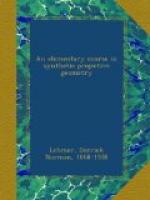The asymptotes cut off on each tangent a segment which is bisected by the point of contact.
114. If we draw a line OQ parallel to AB, then OP and OQ are conjugate diameters, since OQ is parallel to the tangent at the point where OP meets the curve. Then, since A, P, B, and the point at infinity on AB are four harmonic points, we have the theorem
Conjugate diameters of the hyperbola are harmonic conjugates with respect to the asymptotes.
115. The chord A"B", parallel to the diameter OQ, is bisected at P’ by the conjugate diameter OP. If the chord A"B" meet the asymptotes in A’, B’, then A’, P’, B’, and the point at infinity are four harmonic points, and therefore P’ is the middle point of A’B’. Therefore A’A” = B’B" and we have the theorem
The segments cut off on any chord between the hyperbola and its asymptotes are equal.
116. This theorem furnishes a ready means of constructing the hyperbola by points when a point on the curve and the two asymptotes are given.
[Figure 29]
FIG. 29
117. For the circumscribed quadrilateral, Brianchon’s theorem gave (§ 88) The lines joining opposite vertices and the lines joining opposite points of contact are four lines meeting in a point. Take now for two of the tangents the asymptotes, and let AB and CD be any other two (Fig. 29). If B and D are opposite vertices, and also A and C, then AC and BD are parallel, and parallel to PQ, the line joining the points of contact of AB and CD, for these are three of the four lines of the theorem just quoted. The fourth is the line at infinity which joins the point of contact of the asymptotes. It is thus seen that the triangles ABC and ADC are equivalent, and therefore the triangles AOB and COD are also. The tangent AB may be fixed, and the tangent CD chosen arbitrarily; therefore
The triangle formed by any tangent to the hyperbola and the two asymptotes is of constant area.
118. Equation of hyperbola referred to the asymptotes. Draw through the point of contact P of the tangent AB two lines, one parallel to one asymptote and the other parallel to the other. One of these lines meets OB at a distance y from O, and the other meets OA at a distance x from O. Then, since P is the middle point of AB, x is one half of OA and y is one half of OB. The area of the parallelogram whose adjacent sides are x and y is one half the area of the triangle AOB, and therefore, by the preceding paragraph, is constant. This area is equal to xy . _sin__ {~GREEK SMALL LETTER ALPHA~}_, where {~GREEK SMALL LETTER ALPHA~} is the constant angle between the asymptotes. It follows that the product xy is constant, and since x and y are the oblique cooerdinates of the point P, the asymptotes being the axes of reference, we have




